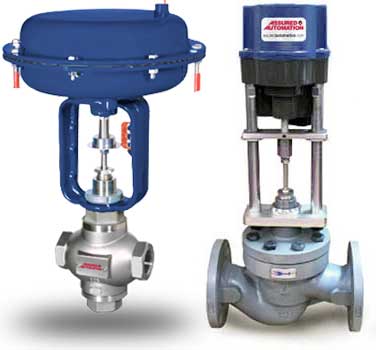How Control Valves Effect Energy Efficiency in Industrial Settings
How Control Valves Effect Energy Efficiency in Industrial Settings
Blog Article

Maximize Power Financial Savings and Convenience With Advanced Structure Automation Controls
In the world of modern-day design and facility administration, the integration of innovative building automation controls stands as an essential improvement. By using the power of automation, buildings can adjust, respond, and advance in methods that were as soon as unthinkable.
Power Effectiveness Perks
Power efficiency advantages can substantially reduce energy usage and operational expenses in buildings. Energy-efficient systems, such as sophisticated structure automation controls, can optimize the usage of resources like lighting, air conditioning, and heating, leading to reduced energy expenses over time.
Furthermore, boosted power performance can prolong the life expectancy of building tools and systems. By running a lot more efficiently, a/c systems, lighting fixtures, and other building parts experience much less wear and tear, causing lowered upkeep and replacement prices. Additionally, energy-efficient structures frequently regulate higher residential or commercial property worths and rental rates, providing long-term economic advantages to proprietors.
Additionally, power effectiveness can enhance owner convenience and productivity. Properly managed indoor atmospheres with ideal lights and thermal conditions produce an even more enjoyable and favorable workspace, causing improved employee fulfillment and efficiency. Overall, the energy performance benefits related to innovative structure automation controls are multifaceted, including cost financial savings, ecological stewardship, and owner health.
Improved Convenience Control
Enhancing comfort control in building atmospheres calls for an innovative assimilation of innovative automation systems for ideal passenger wellness. By making use of innovative building automation controls, centers can tailor the interior atmosphere to satisfy the specific requirements and preferences of residents. These systems allow accurate law of temperature level, illumination, and ventilation, developing a efficient and comfortable ambience. Passenger complete satisfaction and performance are carefully linked to thermal convenience, making it important to have systems in area that can adjust to changing problems in real-time.
Boosted comfort control goes beyond standard temperature level modifications. It includes functions such as tailored settings, tenancy sensors, and all-natural light usage to develop a dynamic and receptive setting. By incorporating these innovative controls, buildings can not just enhance comfort however additionally boost power efficiency by enhancing system operations based upon real occupancy and usage patterns. Inevitably, prioritizing occupant comfort via sophisticated automation systems brings about a more delightful and much healthier indoor setting.
Functional Efficiency Improvements
Moreover, the application of real-time tracking and analytics devices makes it possible for building drivers to recognize power inadequacies and operational anomalies quickly. By constantly keeping track of energy use patterns and system performance metrics, modifications can be made in real-time to enhance energy intake and guarantee peak operational performance. control valves. Furthermore, integrating demand feedback approaches into building automation controls can better boost operational efficiency by dynamically readjusting power use based on grid problems and prices signals
Indoor Climate Optimization
Efficient interior environment optimization is an essential facet of building automation controls, making certain owners' comfort and health while maximizing power financial savings. By making use of sophisticated sensors and controls, constructing automation systems can continually go to this web-site change and keep track of temperature, humidity degrees, air quality, and air flow to create an optimum interior environment. Keeping constant and comfortable problems not only enhances owner satisfaction however also boosts productivity and overall well-being.
Indoor climate optimization additionally plays an important function in energy efficiency. By fine-tuning home heating, air conditioning, and ventilation systems based upon real-time information and tenancy patterns, building automation controls can significantly reduce energy consumption - control valves. For example, executing approaches such as demand-controlled air flow and thermal zoning can assist reduce power waste while ensuring that each area of the structure obtains the essential conditioning.

Sustainable Environment Creation
Building automation controls not just enhance indoor environment conditions for power efficiency and owner comfort however also lay the structure for developing a sustainable setting through strategic monitoring of sources and systems. By integrating sophisticated building automation technologies, such as sensors, actuators, and smart software, centers can adjust and keep an eye on energy usage in real-time to decrease waste and reduce their carbon footprint. These systems enable anticipating maintenance, identifying prospective issues before they intensify and enhancing tools efficiency to improve long life and performance.
Additionally, sustainable environment production prolongs past power administration to encompass water preservation, waste reduction, and interior air quality improvement. Building automation controls can regulate water use, discover leaks, and make certain correct waste disposal practices, adding to total sustainability efforts. In addition, by keeping track of and controlling air flow and filtering systems, these modern technologies enhance resident health and wellness and performance while lowering energy intake connected with cooling and heating operations.
Final Thought
In verdict, progressed building automation controls offer significant benefits in terms of power financial savings, convenience control, operational efficiency, interior environment optimization, and producing a sustainable environment. By executing these controls, structures can achieve ideal efficiency while reducing energy intake and enhancing passenger convenience. It appears that making use of innovative automation modern technology is critical in enhancing structure performance and creating a more sustainable future.
Energy effectiveness benefits can dramatically lower power intake and functional expenses in structures. Overall, the energy efficiency advantages associated with advanced building automation controls are complex, encompassing cost financial savings, ecological stewardship, and occupant well-being.
In addition, incorporating need action approaches into building automation controls can even more enhance operational efficiency by dynamically readjusting energy usage based on grid conditions and pricing signals.
Structure automation controls not only optimize indoor climate problems for energy efficiency and passenger comfort however also lay the structure for creating a lasting setting with calculated monitoring of sources and systems.In conclusion, advanced building automation controls offer significant benefits in terms of power savings, convenience control, operational effectiveness, indoor climate optimization, and producing a lasting atmosphere.
Report this page